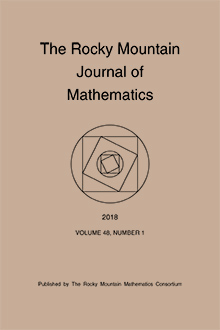Abstract
Triangles having rational sides $a, b, c$ and rational area $Q$ are called \textit{Heron triangles}. Associated to each Heron triangle is the quartic \[ v^2=u(u-a)(u-b)(u-c). \] The Heron formula states that $Q=\sqrt{P(P-a)(P-b)(P-c)}$ where $P$ is the semi-perimeter of the triangle, so the point $(u, v)=(P, Q)$ is a rational point on the quartic. Also, the point of infinity is on the quartic. By a standard construction, it can be proved that the quartic is equivalent to the elliptic curve \[ y^2=(x+ a\, b)(x+ b \,c)(x+c\, a). \] The point $(P, Q)$ on the quartic transforms to \[ (x, y)= \bigg(\frac{-2 a b c }{a + b +c} ,\frac{ 4 Q a b c}{(a+ b+ c)^2}\bigg) \] on the cubic, and the point of infinity goes to $(0, a b c)$. Both points are independent, so the family of curves induced by Heron triangles has rank $\geq 2$. In this note we construct subfamilies of rank at least $3$, $4$ and $5$. For the subfamily with rank $\geq 5$, we show that its generic rank is exactly equal to $5$, and we find free generators of the corresponding group. By specialization, we obtain examples of elliptic curves over $\Q$ with rank equal to $9$ and $10$. This is an improvement of results by Izadi et al., who found a subfamily with rank $\ge 3$ and several examples of curves of rank $7$ over $\Q$.
Citation
Andrej Dujella. Juan Carlos Peral. "Elliptic curves coming from Heron triangles." Rocky Mountain J. Math. 44 (4) 1145 - 1160, 2014. https://doi.org/10.1216/RMJ-2014-44-4-1145
Information





